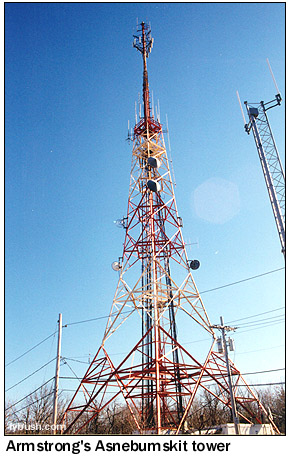 March 13-20, 2003 March 13-20, 2003
Asnebumskit Hill (and Little Asnebumskit), Paxton, Mass.
If you're looking for important sites in the history of FM
broadcasting, it's hard to beat New England and the northeast!
Previous installments of Tower Site (and have you checked out
our comprehensive index?) have taken
us to the top of Mount Washington, New Hampshire and to Alpine,
New Jersey, where FM radio began at the hands of Major Edwin
Howard Armstrong.
This week, we present some pictures from a clear, crisp day
in the fall of 2001, when our travels around central Massachusetts
took us to another pioneering site, the rise of land northwest
of Worcester called Asnebumskit Hill in the town of Paxton, Massachusetts.
On May 27, 1939, Major Armstrong signed on an FM station here
under the calls W1XOJ, part of the Yankee Network's regional
FM service and a critical link between the Armstrong-built stations
at West Peak in Meriden, Connecticut and the Mount Washington
transmitter. W1XOJ was soon being used as part of a programming
relay that brought broadcasts from Armstrong's own W2XMN at Alpine
all the way to Mount Washington - and to nearly all of New England
in the process.
W1XOJ became W43B, a commercial license (the "B"
standing for Boston, 45 miles or so distant), and with 300 kW
ERP at 44.3 was, for a time, the most powerful FM station in
the world. After World War II, when FM moved up the dial, W43B
became WGTR (for "General Tire and Rubber," which had
purchased the Yankee Network) on 99.1 and later 103.1 MHz.
General Tire's focus was on Boston rather than Central Massachusetts,
though - and the company had plenty to focus on there: WNAC radio
(originally on 1260, later on 680), WNAC-FM (on 98.5, with the
transmitter that had been in use on Mount Washington, by then
shuttered) and the new WNAC-TV on channel 7. So the company sold
WGTR around 1950, and within three years the first FM station
in Massachusetts had closed down for good.
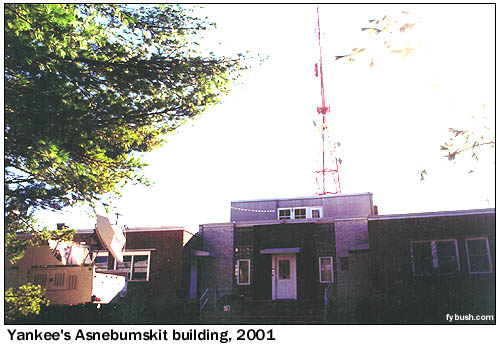 Asnebumskit
returned to the airwaves almost immediately - but on the television
dial. WWOR-TV signed on from the Armstrong facility in December,
1953, operating in the hinterlands of the UHF dial on channel
14. Salisbury Broadcasting owned the station, which was affiliated
with the struggling ABC and DuMont networks, along with a secondary
NBC affiliation that allowed channel 14 to pick up whatever shows
WBZ-TV (Channel 4) in Boston chose not to carry. The combination
of weak networks and the absence of UHF receivers spelled doom
for WWOR, as for so many early UHF'ers, and channel 14 fell silent
in September, 1955. Asnebumskit
returned to the airwaves almost immediately - but on the television
dial. WWOR-TV signed on from the Armstrong facility in December,
1953, operating in the hinterlands of the UHF dial on channel
14. Salisbury Broadcasting owned the station, which was affiliated
with the struggling ABC and DuMont networks, along with a secondary
NBC affiliation that allowed channel 14 to pick up whatever shows
WBZ-TV (Channel 4) in Boston chose not to carry. The combination
of weak networks and the absence of UHF receivers spelled doom
for WWOR, as for so many early UHF'ers, and channel 14 fell silent
in September, 1955.
But channel 14's story was far from over. With a signal that
reached into Boston, Providence, southern New Hampshire and eastern
Connecticut, it was an attractive target for the ambitious UHF
operators at WWLP (Channel 22) in Springfield, which bought the
station in 1958 and returned it to the air as a simulcast of
WWLP and its satellite, WRLP Channel 32 in Greenfield.
As our colleague Peter George explains in his "UHF Morgue"
history (check it out at www.radiodxer.com!):
This would be the "norm" for Channel 14 for the
next six years until December, 1964 when they decided to experiment
with 6 to 7 hours a day of independent of programming, except
for the Huntley/Brinkley Report and the WWLP-TV News from Springfield.
With the 1964 "all-channel legislation" now being the
law of the land, Springfield Television decided to try let Channel
14 become the first true Independent UHF TV station in the Greater
Boston/Worcester area since the demise of WTAO-TV/Channel 56
in Cambridge and WNET-TV/Channel 16 in Providence, several years
before. WJZB-TV provided local sports programming from Assumption
College in Worcester, plus Boston Celtics Basketball and Boston
Bruins Hockey. Also, they bought a package of feature length
movies and some syndicated product such as Ripcord, Susie, Highway
Patrol and The Aquanauts. They also got other syndicated sports
programs such as Roller Derby and Kyle Rote's World. As usual,
they also had some "table scraps" such as "travelogues"
and standard "filler material" to round out the day.
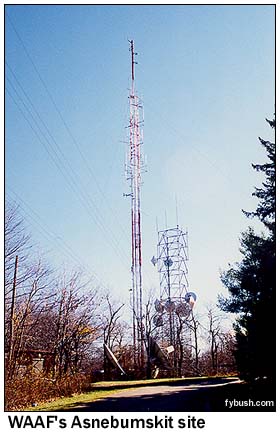 Under its new calls
of WJZB-TV (for WWLP staffer John Z. Buckley), channel 14 struggled
along as an independent for three more years. By 1967, it was
down to just 90 minutes of programming a day - WWLP news, "Western
New England Highlights," the "Huntley-Brinkley Report"
- and sign-off at 7:30 PM. In 1968, the station was sold; a year
later, it suffered a fire that took it off the air once and for
all, cancelling big plans to install a new color transmitter
and even to relocate to the new Needham tower that was going
up for channels 25, 38 and 56. Under its new calls
of WJZB-TV (for WWLP staffer John Z. Buckley), channel 14 struggled
along as an independent for three more years. By 1967, it was
down to just 90 minutes of programming a day - WWLP news, "Western
New England Highlights," the "Huntley-Brinkley Report"
- and sign-off at 7:30 PM. In 1968, the station was sold; a year
later, it suffered a fire that took it off the air once and for
all, cancelling big plans to install a new color transmitter
and even to relocate to the new Needham tower that was going
up for channels 25, 38 and 56.
(Worcester would return to the TV dial in 1970 with the debut
of State Mutual's WSMW on Channel 27, operating from Stiles Hill
in Boylston; Asnebumskit itself would once again get a TV station
in the late nineties with the advent of WYDN on channel 48, a
full-time relay of the Daystar religious network, operating from
the very same Armstrong building and tower as WWOR/WJZB all those
years ago!)
In the meantime, though, the ghost of W43B/WGTR was stirring
on the hill. WGTR's sister AM station in Worcester was WAAB (1440),
whose peripatetic history we chronicled last
week, and while WGTR went silent, WAAB flourished. In 1961,
WAAB launched WAAB-FM on 107.3, and naturally enough looked to
Asnebumskit and the old Armstrong tower as the site.
It was an outstanding choice - from here, signals can be heard
all the way from the Atlantic Ocean to the New York state line.
Under the new calls of WAAF, which 107.3 adopted in 1967, the
facility quickly became more than just a Worcester station. By
the nineties, WAAF had found a niche as the hard-rock station
for headbanger types all over southern New England - and with
its sale to American Radio Systems in 1996, it was reunited (so
to speak) with its long-lost Yankee Network sister stations,
WRKO (the former WNAC) and WBMX (the former WNAC-FM). A later
sequence of purchases would put WAAF and WRKO in the hands of
Entercom, and today they share a studio complex in the Boston
neighborhood of Brighton.
(By then, WAAF had moved off the Armstrong tower to a separate
tower nearby, as shown above; it holds a pending CP to move to
the channel 27 tower in Boylston and change city of license from
Worcester to Westborough.)
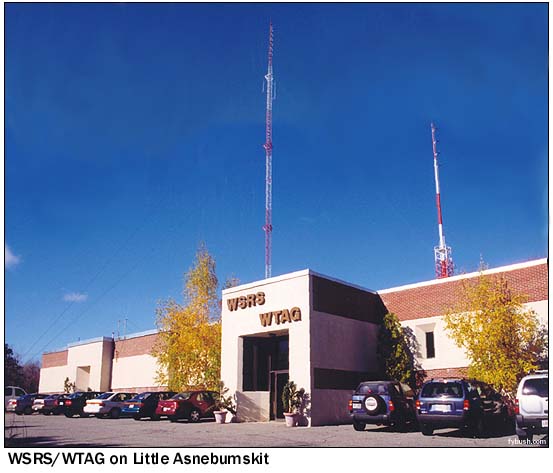 Our last stop on
Asnebumskit is actually just as historic as the Armstrong site,
even if it doesn't always get the respect it deserves. Our last stop on
Asnebumskit is actually just as historic as the Armstrong site,
even if it doesn't always get the respect it deserves.
On June 17, 1940, the Worcester Telegram and Gazette put
W1XTG on the air from the WTAG (580) transmitter site in Holden.
Within a few years, it had moved to a spot called Little Asnebumskit
Hill, just down the hill from Armstrong's site - where it became
commercial WTAG-FM after the war, first at 102.7 and later at
96.1 MHz.
In 1963, the newspapers sold WTAG-FM to Knight Quality Stations,
which flipped 96.1 to WSRS, "Worcester's Stereo Radio Station,"
broadcasting beautiful music and showtunes in stereo every day
from 4 PM until midnight. Today, WSRS is an AC station, and by
far the most successful FM station in the Worcester market. (Though
its signal reaches almost as far into Boston and neighboring
markets as WAAF's, WSRS has always chosen to focus on central
Massachusetts in its sales and imaging.)
WSRS was reunited with WTAG in the eighties, when Knight bought
the AM station as well from the newspaper (by then the merged
Telegram and Gazette); WTAG's studios moved up to Asnebumskit
from the newspaper building in downtown Worcester. A later sequence
of sales found WSRS/WTAG in the hands of Capstar and eventually
Clear Channel, which still owns the stations. In the photomontage
shown here, that's the original 1940s-era tower at the right;
WSRS's main antenna now sits on the taller tower in the center
of the image.
That's a lot of history for just a single turn off Route 56
in Paxton, isn't it?
Next week, we'll head for the sun as we begin a long-promised
look at the towers of San Diego (and even a quick jaunt across
the border to see some of the sticks of Tijuana!)
In the meantime, there's plenty of good material available
on the Web about the history of Asnebumskit and the early years
of Armstrong and Yankee FM. Three good places to visit:
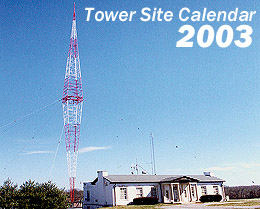 Want to see more neat sticks all year
round? Nashville's WSM (at left) is one of the more than
a dozen Tower Site images featured in the 2003 Tower Site Calendar,
still available from Tower Site of the Week and fybush.com. Want to see more neat sticks all year
round? Nashville's WSM (at left) is one of the more than
a dozen Tower Site images featured in the 2003 Tower Site Calendar,
still available from Tower Site of the Week and fybush.com.
If you liked last year's edition, you'll love this one: higher-quality
images (in addition to WSM, this year's edition includes Providence's
WHJJ; Mount Mansfield, Vermont; Buffalo's WBEN; KOMA in Oklahoma
City; WTIC, Hartford; Brookmans Park, England; WPAT, Paterson;
Four Times Square, New York; WIBC in Indianapolis; WWVA in Wheeling,
W.V.; WGN Chicago and more), more dates in radio history, a convenient
hole for hanging - and we'll even make sure all the dates fall
on the right days!
This year's edition is still available in limited quantities!
Orders placed now will be shipped within 24 hours! And this
year, you can order with your Visa, MasterCard, Discover or American
Express by using the handy link below!
Better yet, here's an incentive to make your 2003 NERW/Site
of the Week subscription pledge a little early: support NERW/fybush.com
at the $60 level or higher, and you'll get this lovely calendar
for free! How can you go wrong? (Click here
to visit our Support page, where you can make your NERW contribution
with a major credit card...)
You can also order by mail; just send a check for $16
per calendar (NYS residents add 8% sales tax), shipping included,
to Scott Fybush, 92 Bonnie Brae Ave., Rochester
NY 14618.
Thanks for your support!
|